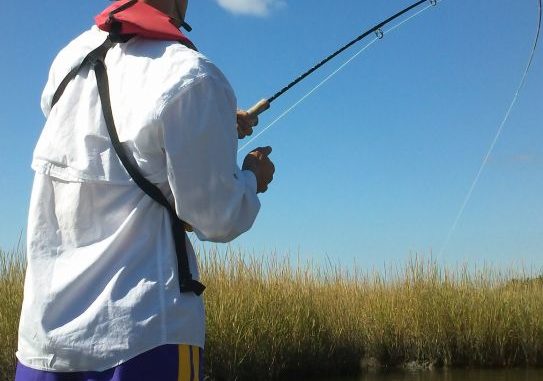
When ‘popper-tunity’ knocks, fish answer!
I was so ecstatic when Texas A&M joined the Southeastern Conference three years ago. As an LSU fan, in addition to renewing one of our traditional rivalries, it was a chance to revive some of my favorite Aggie jokes.
“The Aggies were coming to Baton Rouge to play the Tigers. As their bus approached the campus, they saw a sign that read ‘LSU Left.’ So they went home.”
“Heard about the Texas Aggie who became a carpenter? He cut a board. It was too short. He cut it three more times. It was still too short.”
Unfortunately that last joke reminds me of a couple of my fly fishing pals. They’ll fish a crab pattern for redfish no matter the season or conditions. Like the Aggie’s stub of a board, they’re happier going home short-handed… as long as they used their crab fly!
There’s no denying that a crab pattern or charlie or spoon fly are the best flies to catch reds. Or that a weighted clouser under a VOSI is the best technique to catch speckled trout.
But this is fall. And fall offers the best opportunity for the most exciting fishing of all — poppers!
You never know what you’ll catch on a popper in the Louisiana marsh. Over the past 25 years, I’ve caught hundreds of reds, countless trout, a few sheepshead, a few gafftops, a few stripers, a couple drum, a lost mangrove snapper, a baby tarpon and even three flounder!
There’s nothing quite as exciting as watching a redfish or trout attack a popper! Especially a red, since its mouth is on the underside of the head. For a red to eat a popper, much of his head has to come out of the water.
Several Octobers back, we were fishing the edge of Lake Laurier near Fourchon from our canoe, casting pencil poppers to speckled trout. Suddenly a head — the size of a basketball — came completely out the water and ate my popper!
I was in shock from watching that bull red attack, but quickly gathered my wits and set the hook. For the next 45 minutes, that redzilla gave our canoe a “Cajun Sleigh Ride.” In the end, my poor little 7-weight rod was no match for the 30+ pound beast. It broke my rod, my leader and my heart!
We were using foil pencil poppers that day because the water was clear. In clear water, making noise isn’t as critical in attracting predators as matching the hatch.
This type of pencil popper is basically a thin foil wrapped over a balsa body. The reflective foil gives it a reflective imagery similar to any number of baitfish.
You really don’t pop a pencil popper. You give it a few erratic strips. It’s like working a Zara Spook on a commie rod.
Another reflective fly is the Crease Fly. It’s tied using a strip of something called Loco Foam folded over a threaded hook shank. The foam has a holographic texture.
Crease flies don’t pop well either. But the gap in the folded foam creates air bubbles when stripped. It must do something to excite trout because they absolutely love this fly.
If you want “pop” in your fly, then Pete’s Perch Float Popper is the ticket.
I’ve written about this fly before. It’s basically half-a-cigar-float epoxied on a hook and painted to style. Grinding out a concave face on the fat side of the half-float gives it the pop. Detailed instructions on how to tie can be found by searching the Fly Lines archives on LouisianaSportsman.com.
Created by my friend and Louisiana fly fishing legend Pete Cooper, Jr., the Pete’s Popper is not found in any shops. A very similar fly — the Dink — is. I prefer Dinks in size 2.
In off-colored water, give the Pete’s Popper or Dink a small jerk with your rod to get the popping sound. Does it work? My friend Jody Titone once caught a 9-pound red using a Dink in water that resembled chocolate milk!
If I’m going after big specks I use a Skipping Bug. These come in sizes 1/0 to 4/0. No need to pop these babies. Just by sheer size, they push a lot of water when stripped. Which in turn attracts fish.
So when do poppers work best?
The vast majority of my topwater catches have come under one or more of the following conditions: from first light to mid-morning, late in the afternoon, on overcast or foggy days, under calm or light breezes, in cuts or points on moving tides, around broken grass or perimeters of small islands.
As exciting as popper fishing is, it can be equally frustrating. A speck or red will often strike and miss multiple times. You have to be extremely patient and wait for the hook set.
If the fish continues to follow but not eat, don’t keep stripping. Immediately initiate a backcast, then forward cast to the spot the fish is at. Sometimes a fish realizes he missed an easy meal. He would love a second chance. Give him that second chance!
Now through December is the best time for poppers. Carpe diem! My Aggie friends translate it as “Let’s go catch some carp.” But it means “seize the day.” In other words, put poppers in your fly box!


